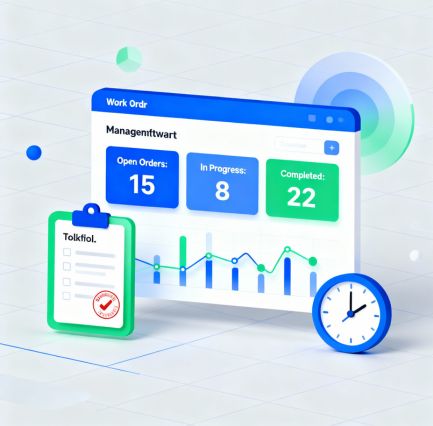Work Order Management Software: The Ultimate Guide to Streamlining Operations in Today's Business World

In today's fast-moving business world, staying on top of tasks at hand, maintenance schedules, asset upkeep, coordination with teams, and customer expectations has become more challenging than ever. Be it the manufacturing plant, facility management company, service-based enterprise, logistics operation, or multi-location business-the one thing that remains constant is the work order, which is considered the backbone to the smooth running of operations.
But to manage them manually?
That is where most companies start finding it tough.
Paper-based systems get lost.
Spreadsheet-based work orders become outdated.
Technicians forget to do things.
Communication breakdowns.
Assets go unmaintained.
Downtime increases.
Productivity is the worst hit.
That's precisely why organizations of today, whether small, medium, or enterprises, are moving to Work Order Management Software. This software has become instrumental in simplifying operations, automating tasks, and giving real-time insight over everything happening across the business.
If you're looking to understand how Work Order Management Software works, why it matters, and most importantly, how it can transform your operations, this comprehensive guide is meant for you. Let's get deep into all the information you might need to know.
What is work order management software?
Work Order Management Software is a digital platform that assists businesses in creating, assigning, tracking, and accomplishing work orders with efficiency. Instead of using paper, scattered communication, or manually updating, this software centralizes everything in one place within a streamlined system.
By using the right solution, teams can:
Create work orders in a snap
Auto-assign jobs to technicians
Monitor work progress at real-time.
Manage assets, maintenance, and schedules
Store past service history
Minimize down-time
Operational efficiency improvement
In a nutshell, Work Order Management Software keeps the work orders flowing smoothly and in coordination, thereby guaranteeing that your enterprise becomes a well-oiled machine.

Why Work Orders Matter More Than You Realize
Every industry uses work orders, even if they don't call them that.
Everything-from repair jobs and facility inspections to quality checks and preventive maintenance-starts with a documented request for a task. But here's where most companies struggle:
Lack of clarity in the working instructions.
No proper timeline or priority management.
Approvals get delayed.
Team members miss updates
Accountability cannot be followed.
Reporting and analytics are not complete.
That's why work order management software is not just a digital tool but rather a core system through which execution, accountability, and operational excellence are supported.

Top Challenges Businesses Face Without Work Order Management Software
So, before we start to talk about automation and digital transformation, it is important to understand what companies usually deal with while still using outdated methods.
1. Deferred Work Assignments
Manual communication often causes confusion, when teams don't know which task is assigned to whom, which delays the process and causes inefficiency.
2. Common Mistakes and Misunderstandings
Paper notes and oral instructions are also liable to errors. A single item of information lost may hinder an entire maintenance cycle or production line.
3. Poor Assets Management
Without structured tracking, asset downtime increases, maintenance becomes unpredictable, and repair costs escalate.
4. Lack of Real-time Visibility
Often, managers have no indication of which work orders are pending, in progress, or completed.
5. Lack of Accountability
There is no clear audit trail, making it very difficult to identify delays or measure technician efficiency.
6. Zero Reporting & Insights
Without data, optimization becomes a guessing game.
This is where Work Order Management Software becomes a game-changer, rectifying all these issues and helping teams become proactive rather than reactive.
How Work Order Management Software Solves These Problems
Now, let's break down how the right system can transform everyday operations:
1. Centralized Dashboard for Total Control
Every work order, task, technician update, asset detail, and history are all kept in one place.
No more hunting through emails or WhatsApp messages.
2. Automated Task Assignments
Work orders are routed instantly to the right technician according to:
Skill
Location
Priority
Availability
This reduces delays and ensures faster turn-around time.
3. Real-time Tracking
Managers may see:
Who is working on what
What's pending
What's overdue
What's done
This visibility facilitates the making of better and quicker decisions.
4. Improved Communications
Technicians receive instantaneous updates, upload completion photos, add notes, track spare parts used, and update the job status live.
5. Improved Asset Life
Preventive and predictive maintenance can increase uptime and decrease breakdowns, thereby saving money in the long run.
6. Full History & Audit Trails
Everything is tracked by action, so it is transparently traceable.
7. Powerful Analytics & Reports
Understand:
Technician productivity
Asset health
Work order volume
Repeated failures
SLA adherence
Cost patterns
Data helps to optimize operations at all levels.
For whom is work order management software used?
This solution is not industry-specific; rather, it is devised for any organization involved in recurrent tasks, maintenance, or service operations. The most benefiting industries include:
Manufacturing
Facilities Management
Property management
Logistics & warehouses
Oil & gas
Car workshops
Hospitals & healthcare
Hotels & hospitality
Building
Utilities & energy companies
IT service teams
Government bodies
Educational institutions
This provides structure, efficiency, and clarity to the day-to-day operations in all these sectors.
Key Features in a Work Order Management Software You Should Seek
While there are many tools available, the best ones share a core set of features that help businesses run smoothly:
1. Intelligent Creation of Work Orders
Create work orders with the following information easily:
Priority
Deadline
Asset name
Location
Category
Required parts or tools
Assigned technician
2. Scheduling Preventive Maintenance
Automate routine maintenance based on
Time
Usage
Condition
Meter readings
This helps to avoid unexpected breakdowns.
3. Technician Mobile Application
Field technicians should be able to:
Check assigned tasks
Update work status
Upload images
Scan QR codes
Log usage of parts
Capture signatures
Mobility increases the speed with which tasks are completed.
4. Asset Tracking
Health, repairs, preventive logs, and warranty information of every asset should be stored digitally.
5. Real-time notifications
Alerts for:
New assignments
Approvals
Overdue tasks
Planned maintenance
Finished work
6. Inventory & Spare Parts Management
Know which spares are available, stock levels, and usage history.
7. Custom Reports & Dashboards
Data-driven insights help optimize workforce performance.
8. Vendor Management
Working with contractors will make it easier when it comes to tracking performance.
9. Access via Cloud
Teams working seamlessly from anywhere.
10. Integrations
It should integrate with:
ERP
CMMS
Billing systems
IoT devices
CRM
Ticketing tools
Productivity increases in a connected ecosystem.
Benefits of Using Work Order Management Software
Let me break this down to key advantages businesses unlock:
1. Completes 40–60% of Tasks Faster
Automated workflows eliminate misunderstandings and delays.
2. Reduced Downtime
Preventive maintenance scheduling keeps your assets from breaking down.
3. Boost Team Productivity
It gives technicians clear instructions and updates in real time.
4. Stronger Accountability
Each process is documented step by step.
5. Improved Customer Satisfaction
Quick service equals happy customers.
6. Decrease operational costs.
Optimized maintenance reduces costs in the long run.
7. Better Communication
No more missed calls, lost messages, or out-of-date spreadsheets.
8. Real-time visibility
Status is always known by managers.
9. Better Decision Making
Analytics help pinpoint bottlenecks and enhance planning.
10. Scalability
Whether you have 10 employees or 10,000, the system grows with your business.

Why work order management software is becoming indispensable for any modern business.
Increased automation, more stringent compliance requirements, complex assets, and growing expectations from operations have all made a digital work order system a critical initiative.
Here's why businesses are fast adopting it:
Manual tracking no longer supports business speed.
Teams are becoming more distributed
Real-time communication is necessary.
The basis of every decision should be evidence-based.
Customers want faster service.
Preventive maintenance is now the norm.
It is vital that businesses cut down on extra costs and maximize efficiency.
Work orders are central to daily operations, and digitization is no longer a luxury, it is absolutely necessary.
How to Choose the Right Work Order Management Software
The right tool will, of course, depend upon your business needs. Here's what to consider:
1. Ease of Use
Adaptation should be fast within your team.
2. Customizability
Every business is different-software needs to be adaptable.
3. Cloud-Based Mobility
Remote teams should perform seamlessly.
4. Strong Support & Training
Look out for a service provider that offers onboarding, documentation, and special support.
5. Scalability
Choose a solution that grows with your business.
6. Integration Capabilities
It has to integrate with your existing systems.
7. Pricing
What counts is transparent pricing-monetary return on investment, not necessarily the cheapest.
Future of Work Order Management: What's Coming Next?
The next generation of Work Order Management Software will be significantly more powerful, with enhancements in:
AI automation
Predictive Maintenance with Machine Learning
IoT device integration
Digital twins
Smart asset monitoring
Automated inventory forecasting
Creation of voice-based tasks
Augmented reality for technician support
Business firms that implement digital solutions at present will have a competitive advantage over others for the next decade.
Conclusion: Why Your Business Needs Work Order Management Software Today
Work Order Management Software is the most crucial tool to invest in for enhancing operational efficiency, reducing downtime, empowering your team, and running a more productive business. It helps you: Manage daily activities Improve technician accountability Manage assets prudently Automate repetitive tasks Effortless performance tracking Deliver faster, higher-quality service Reduce operational costs Build long-term operational excellence Due to digital transformation, businesses around the world are adopting these systems. Organisation that adopt them early gain huge advantages in productivity and profitability. If you want smoother workflows, better visibility, and higher efficiency, it's time to consider implementing Work Order Management.



.png)
